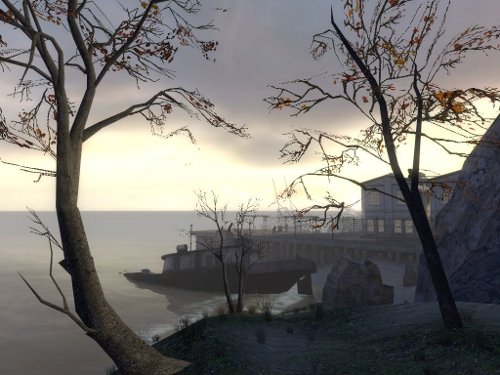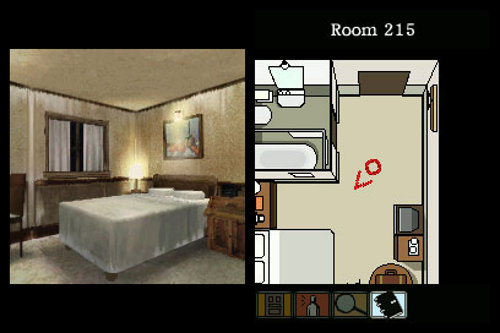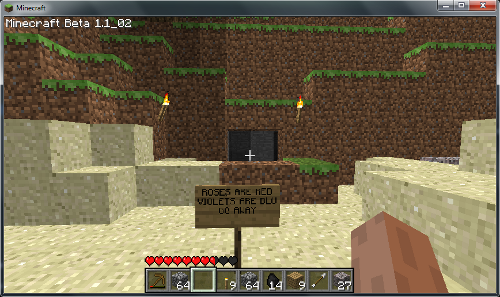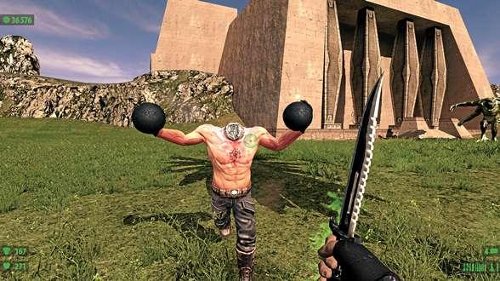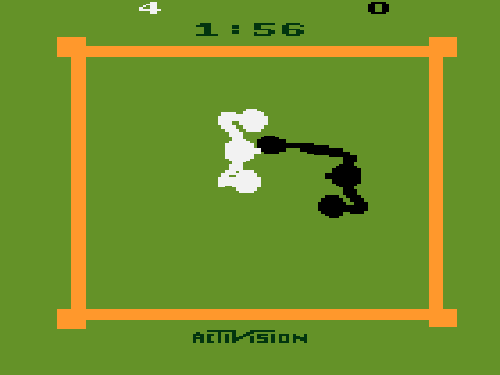home // text // multi-media // misc // info
video-games musings game-design procedural-content My Holiday Playlist
The holidays may be over, but that doesn’t mean the holidays are over! What?
This latest holiday season was a resounding success, filled (as expected) with relaxation, family and friends, and the consumption of various foodstuffs, ethanols, and multimedia products. I thought I’d take a few paragraphs to exercise my vocabulary and look back at some of the games tiding me over between foodbabies.
MINERVA: Metastasis (PC)
Ah, Newfoundland.
My friend and Mount Royal Game Society co-organiser Six suggested I take a look at this Half-Life 2 mod, marketing it to me as (paraphrasing) “an exploration of a more fully-realised space than the constantly advancing roller-coaster of HL2.” It was interesting to note the process of familiarisation within the facility, learning the architecture and eventually improvising and using it to my advantage in firefights. On the other hand, a few areas do feel a bit arbitrarily designed (or, don’t seem to make architectural “sense”), simply to provide certain encounter types: e.g., long, tight hallways, or an emphasis on z-axis fighting. And, on the larger scale, it did sometimes feel like a repetitious cycle of Exploration-Stockroom-Encounter, Exploration-Stockroom-Encounter, of the type that Valve (as I recall) cleverly managed to avoid in HL2.
That said, another interesting aspect of the game is the player’s dependence on the character of Minerva. She (it?) is manifested as nothing but the occasional text message—varying in tone from concerned to hostile to dispassionate—but, since she’s the one giving motivation and context to the mission, she develops something like a caregiver’s presence. More than once, I found myself hoping for her reassurance or guidance so that I wouldn’t have to proceed “blindly.” And all that simply from a smattering of scripted text.
Hotel Dusk: Room 215 (DS)
Mirrors on the ceiling, pink champagne on ice.
And she said: “We are all just prisoners here, of our own device.”
I actually got game this as a Christmas gift, since it was on my oh-so-handy wish list. Obviously, points for style and originality on this one: it’s a film noir game, on a DS that you hold like a book, set in late-1970’s California. I’ve really only just started out, but the characters have already made an impression, and the narrative has introduced a number of unknowns and mysterious coincidences that really capture the feel of the older film noir movies.
Hotel Dusk makes use of the adventure gaming trope of discrete time blocks, similar to The Colonel’s Bequest or the Gabriel Knight series: that is, the player solves a few puzzles and witnesses certain events within, say, fifteen minutes of game-world time, before advancing to the next time block or chapter. I know opinions will vary, but I really dig this format. Despite the arbitrariness of the time blocks—one “half-hour” block of game time might take several hours or just ten minutes to play—I’ve always felt that they lend a kind of pacing and a sense of progress, almost desperation, as the storyline races against the clock. This can obviously work against a given game, but so far Hotel Dusk pulls it off well. My only complaint is that there are only one or two very specific puzzles/dialogues that occur in each time block, so the game ends up feeling mostly linear. Regardless, the story and setting are definitely compelling enough to keep me playing more for now.
Minecraft (PC)
No Admittance Except on Party Business
Maybe you’ve heard of Minecraft. It’s sort of popular now.
I first played it way, way back, around when it first popped up online—this was while researching existing games with procedural content generation, and before the recent Minecraft-mania. (Oh shoot, did I just say I played Minecraft before it was cool?) I thought the landscapes were pretty interesting, though I didn’t think much of it as a game, per se. Fast-forward a few months, and notch [RIP] was suddenly contemplating how to avoid papercuts while sleeping on piles of cash; Minecraft-mania had finally hit. Figuring I must have missed something, I paid for the stand-alone alpha and gave it a second chance.
Once again, I just didn’t get it. Obviously, creations like the Enterprise D or a working logic unit were impressive, and player-generated stories/adventures/mishaps (such as the Great Fire of Minecraft) were fantastic (and usually tragic), but for the life of me I couldn’t stay interested beyond the point of making my first torch and digging deep enough to need the latter. My interest waned once more, until finally, during the holidays, I decided that perhaps the third time would be the charm, and fired it up again. This time, I’ll admit I played a bit longer: my spawn point was on an island, and I resolved to dig myself the equivalent of the Chunnel to connect to the mainland. But once that was finished (read: when the tunnel accidentally flooded), I was again left standing (swimming) with nothing to do. It was at that moment, I believe, that it hit me.
I claim that Minecraft is a toy, not a game. My friend Matthew was elegant and concise: “There are no explicit goals or directives, just a wonderful sandbox of pure undirected play” (emphasis mine). There is nothing in Minecraft beyond what the players make for themselves, literally and figuratively. It’s a formula that clearly resonated with a lot of people, and it’s probably a revolutionary step (that is, the most recent and most successful) in the exploration of agency and game-like systems, but I don’t connect with it. When I was younger and played with Lego, I’d make the object as per instructions, and to hell with the “suggested variations” on the back of the box. I suppose I’ve always just been more interested in having a clear direction and purpose—even if I occasionally veer away from it. Compare and contrast Minecraft with Dwarf Fortress: in the latter, the geographical and political history, as well as the individual dwarfish personalities, gives me a much greater sense of context and motivation than I ever found in Minecraft, and I can therefore enjoy DF much more thoroughly (modulo their respective interfaces).
My full and sincerest respect goes to @notch: here is an individual who, in a few months, managed to single-handedly put together a project that laid bare the essence of play (creativity and uncertainty in equal parts) and provide a wonderfully meaningful experience for many thousands of people; and all this while making himself a tidy fortune. He is the embodiment of the indie game developer’s dream. But I can say right here, and with absolute certainty, that I’m just not that interested in Minecraft.
[2023 edit: notch is a monster whose copycat game happened, unfortunately, to be the one to change the world. The game & the community have thankfully grown from his poisonous roots into something genuine. Leaving the above in place for a perspective on sweet, innocent 2011.]
There.
Serious Sam: The First Encounter (HD) (PC)
The headcrabs (ironically?) of the Serious Sam universe. So much fun and/or terror.
Right, so, opposite end of the spectrum. Minecraft allows the player to do just about anything; Serious Sam, on the other hand, merely allows them to run, dodge, or shoot, relentlessly. It’s the Army of Darkness of video games: mindless fun from the “Does this make sense? Do we give a fuck?” school of design. And it was part of Steam’s holiday sale.
I’d always been interested in Serious Sam, as it seemed to tap into that sweet spot of speed and mastery that contributed to Doom’s original success. So far, I’m loving every minute of it. It’s unabashedly tongue-in-cheek (the saviour of the universe wears Chuck T’s, for Darwin’s sake), and yet it makes rather smart use of its variety of guns and enemies: I find myself reacting to each encounter and switching between weapons way more often here than in most other FPS’s.
I’m not sure how long they’ll be able to prolong this adrenaline rush, but for right now, it’s just a lot of fun. Full stop.
Boxing (Atari 2600)
Ali vs. Liston (May 25, 1965)
The weekend before the holidays ended, I had some friends over for sushi and media. While I’d planned for movie-watching, we ended up blitzing through my collection of 80+ Atari 2600 games instead, and without a doubt, Activision’s Boxing was the highlight of the night.
The game has comparatively better graphics than most 2600 games, but it’s still extraordinarily minimal (as I pointed out, it looks a lot more like two spiders mating). Given the one-button input from the Atari controllers, it’s rather minimal in terms of interaction as well. And yet…
A successful punch (a shot to the face) at arm’s length lands an attacking player one point, while a punch from in-close gives two points. Two players can face off against each other, or one player can face the CPU, and full games last only two minutes, or until one player achieves a KO (100 points landed on the other boxer). What makes the game special, however, is the reaction to a successful punch: if a player lands a hit with their right hand, the other boxer is pushed towards their waiting left hand and vice versa, creating what a friend mentioned must be one of the first combo systems ever implemented in fighting games. When being attacked with a combo, a player has to try to back away from the attacker, or hope that the latter’s timing is off and the salvo ends naturally; if the defender is up against the ropes, there’s nothing to do but pray the other player’s thumb gets tired. The result is a ruthless and thrilling and almost chess-like strategic battle for domination of the centre of the ring.
Videos don’t do it justice. With an extremely limited set of rules (1. Points for punches at different ranges. 2. A single round with a time and point limit. 3. “Physical” reactions to punches.), Boxing creates what is probably the most distilled and accurate representation of the sport possible. Players grapple, weave, get frustrated, charge, rest; thumb fatigue becomes an actual physical factor; sudden reversals literally bring people to their feet. In fact, the more I think about it, the more I can convince myself that this is the only boxing simulation we ever really needed; the rest are just fluff.
We were bent over laughing and cheering with this game. And I landed something like a 30-hit combo on the computer, for the fastest KO among us. The whole thing was magical.
Back to the salt mines
The holidays are now over, and it’s back to the regular weekday grind. But I like to think I made the most of my gaming opportunities in the meantime.
How about you? What games brought you all through the new year?
